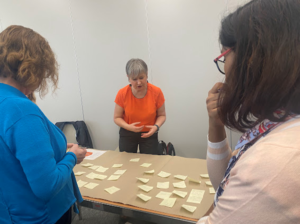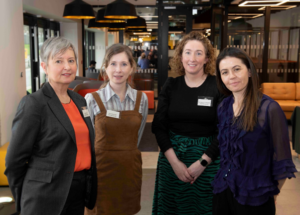The annual iPASTAR (improving Pathways for Acute Stroke and Rehabilitation) Symposium offers the iPASTAR CDA scholars and their supervisors the opportunity to learn from field leaders in Irish stroke research while also showcasing the scholars’ research outputs and future research goals to interdisciplinary colleagues similarly interested in improving patient care, outcomes and experience.
Symposia are important platforms for knowledge sharing, networking and professional development with a focus that centres on a specific topic. This year we included a co-design sprint into our symposium with the additional goal of harnessing the diverse perspectives already gathered in one room, that might enrich our individual PhDs with particular focus on the patient experience of stroke care. The iPASTAR 2023 symposium was held in the RCSI Education and Research Centre at Beaumont Hospital. We were thrilled to welcome participants from broad multi-disciplinary backgrounds including physiotherapy, occupational therapy, speech & language, medical social work, nursing, acute medicine, national audit, HSE/National Programme, voluntary organisations and especially patient representatives.
In this blog article, we discuss the benefits of incorporating a co-design sprint into the iPASTAR Symposium, and provide practical tips for implementation.
Understanding Co-design
Health design thinking aims to generate creative and meaningful solutions to complex healthcare problems that enhance human well-being. Co-design is a collaborative approach that involves engaging diverse stakeholders in a creative design and decision-making process to generate many ideas, not necessarily a single “correct” one. This approach can be particularly useful in health systems research as it incorporates different perspectives and encourages “bottom-up” change ideas development.
There are a number of variations to the design thinking process which generally extends through a four or five-phase process starting with research to gain insight and understanding of the problem, through defining and refining the problem, generating ideas towards new concepts which are then tested and finally implemented. Design sprints follow a structured agenda with reasonable constraints including time and are typically set over 5 – 7 days.

Co-design in the iPASTAR Symposium
Our PhDs focus on all steps in the stroke care chain: improving equity and access to stroke treatments; transitioning home after stroke; living well following stroke and preventing stroke recurrence. Co-design in the iPASTAR symposium involved actively engaging symposium attendees in collaborative activities to contribute their ideas, insights and expertise to solve complex issues along the stroke pathway. Co-design aims to empower participants to become co-creators of potential solutions, to adopt ownership for problem-solving and to generate buy-in for the implementation of possible solutions, making it ideal for efforts to improve this complex care pathway.
To maximise the contributions of the symposium we opted to focus on the ‘ideate’ phase of the co-design approach. During this phase ideas are generated and shared through radical thinking and brainstorming, all ideas are worthy, and judgement is deferred. It is an opportunity to uncover the unexpected and harness the broadest range of ideas from the collective participants. Detailed planning of the sprint was essential so we could succinctly convey the process, purpose and expectations to participants, and our PPI (patient and public involvement in research) group was crucial to this planning phase.
The participants were divided into three groups, and over the course of one hour, they engaged in creative collaboration to generate potential solutions for the challenges faced at particular steps in the stroke pathway – issues with acute care, the transition home and living well after a stroke. In 3 x 20-minute “co-design sprints” participants engaged simultaneously in rapidly generating ideas and suggestions to address the complex issues outlined. We asked participants to contribute their ideas from the seemingly simple solution to blue sky thinking, to be curious, and to generate the broadest range of possibilities/solutions. We followed by asking participants to refine their ideas and consider what might be required to make that solution happen, the “who, why, where, when and how” of the proposed solutions. A rapid synthesis of the ideas generated was fed back to participants as part of the symposium, for example, project 1 received innovative ideas on the potential content and setting of future public awareness campaigns, project 2 received ideas regarding bridging communication gaps between the hospital, the community services and the patient at discharge, while project 3 received insight into the disparate understanding and focus of stroke secondary prevention. These ideas will be incorporated into intervention co-design outputs for the three iPASTAR PhD projects.

Top Tips for an Engaging Co-design Environment
- Use a referenced co-design framework e.g. Stanford D or Double Diamond Design Process Model for planning and execution of a design sprint
- Engage PPI partners at all stages
- Detailed planning is essential, identify the goal and what you hope to accomplish
- Clearly communicate the context, purpose, expectations, and desired outcomes of the co-design tasks
- Set up the activities in an inviting space that allows participants to brainstorm and share ideas
- Use interactive tools or any technology that promotes inclusivity and reflects participants preferences for contributions eg Mentimetre, Jamboard
- Provide relevant supporting materials such as a guiding framework, a patient scenario, thought-provoking questions, and appropriate tools (e.g. post-its, flip charts) to assist participants in activities
- Ensure facilitators have the appropriate training and skills to guide participants through the activities, encourage inclusivity and constructive collaboration, and harvest the collective wisdom of the group
- Allow sufficient time for the co-design activities, to allow for confidence building, collaborative discussions and innovative solutions – but not too much time as it’s a sprint!
- Capture key points and integrate these into the symposium, feeding back to participants as part of the symposium outputs
- Provide a quiet space for participants to retreat to should that be required (this can be important to all but even more so those who have experienced a stroke for whom sensory challenges and fatigue persist)
Conclusion
By embedding a co-design sprint into the iPASTAR symposium, we empowered participants, both professional healthcare staff and patient experts, to actively contribute their expertise, experience and perspectives, to co-create potential solutions for complex challenges along the stroke pathway. The integration of co-design activities into the symposium gave the scholars access to a broad range of opinions from engaged field experts. We feel that the success of our design sprint offers exciting opportunities for future iPASTAR co-design events, enriching our future research outputs.


